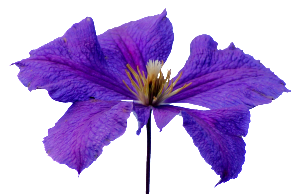Clematis is a herb. People use the parts that grow above the ground to make medicine.
Contents
Uses
- Clematis is used for joint pain (rheumatism), headaches, varicose veins, syphilis, gout, bone disorders, ongoing skin conditions, and fluid retention.
- Some people apply clematis directly to the skin for blisters and in a wet dressing to treat infected wounds and ulcers.
Benefits
- Cancer: Studies at Chonbuk National University Medical School showed that Clematis was able to block pathways needed for the proliferation of cancer cells – thus stopping their growth.
- Type 1 Diabetes: People with type one diabetes no longer have their beta cells creating insulin, and their are some indications that Clematis Root may revitalize beta cells.
- Protect Skin: There is some evidence that Clematis Root can protect the skin from premature aging from UV light exposure. Clematis has been used in the past to keep the skin from becoming dark from sun exposure.
- Antimicrobial: Laboratory studies show that Clematis is a good antibacterial and anti-fungal agent. Great for bacterial staph infections and for candida infections.
- Arthritis and Inflammation: Clematis works well for arthritic pain and pain in general. Studies suggest it might work well for limited motion, contractions of muscles, and even numbness associated with inflammation.
- Induce Labor: Studies with mice show that Clematis can also induce labor. At the same time those who are pregnant or nursing should not use Clematis.
- Smooth Muscle Peristalsis: Laboratory studies show that Clematis can also increase muscles peristalsis of the gut and esophagus.
- Helps with Pain: In Traditional Chinese Medicine Clematis is well known for alleviating pain.
- Saponins: Clematis contains over 20 different saponin compounds that are powerful antioxidant healing agents. Also contains hederagenin and oleanolic acid which are also powerful healing antioxidants.
- Gout: Clematis works great for the redness, pain, and swelling of those suffering from gout.
- Viral Hepatitis: In one clinical study of 35 people infected with viral hepatitis Clematis was over 90 % effective.
- Gallstones: In a study of 120 people with gallstones it was found that Clematis was 87 percent effective in treating symptoms.
- Mastitis: Clematis is also great for healing mastitis – one study showed that with two days of treatment they were totally healed of mastitis.
Cautions
- Fresh clematis should not be taken orally. It can cause colic, diarrhea, and severe irritation to the stomach, intestines, and urinary tract.
- The fresh plant should not be applied to the skin. With extended skin contact and a wet dressing, the fresh plant can cause slow-healing blisters and burns.
- Avoid using during pregnancy and breast-feeding.
Interactions
- We currently have no information for clematis Interactions
Other Names
Clemátide Recta, Clematis recta, Clématite, Clématite Dressée, Clématite Droite, Ground Virginsbower, Upright Virgin’s Bower, Virgin’s Bower.
References
Source: WebMD, http://www.webmd.com/vitamins-supplements/ingredientmono-628-clematis.aspx?activeingredientid=628&activeingredientname=clematis
“13 Health Benefits of Clematis Root” (Dr. Paul Haider, 2015), https://www.linkedin.com/pulse/13-health-benefits-clematis-root-dr-paul-haider

